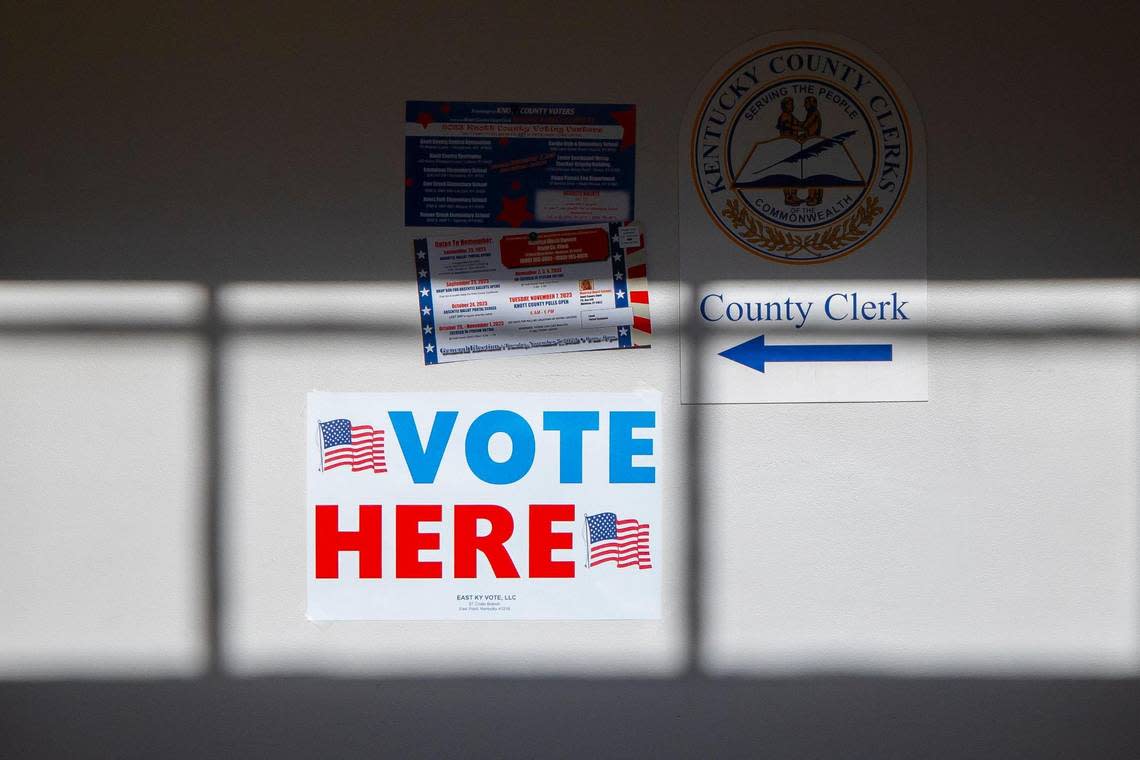Here are 4 things we’re watching on Election Day in Kentucky

- Oops!Something went wrong.Please try again later.
- Oops!Something went wrong.Please try again later.
It’s finally here, Kentucky.
All eyes will be on the Bluegrass State Tuesday as the gubernatorial contest between Democratic Gov. Andy Beshear and GOP challenger Attorney General Daniel Cameron has become the most closely watched of any statewide contest in the nation this year.
Thousands of Kentuckians have already cast their ballots, and hundreds of thousands more will follow suit Tuesday before polls close at 6 p.m. local time.
When the results start to roll in Tuesday night, here’s what Herald-Leader journalists, who have been tracking this campaign for nearly two years, will be closely watching:
What are the margins in Jefferson and Fayette?
When Beshear narrowly beat GOP incumbent Matt Bevin in 2019 by just 5,000 votes, his ability to run up margins in Kentucky’s two most populous counties was key.
In Jefferson County, Beshear won by nearly 99,000 votes. And in Fayette County, he won by more than 36,000 votes.
All in all, Beshear won 23 counties in 2019 — 21 of which were won by President Donald Trump in 2016 — to Bevin’s 97.
Numerous political observers have told the Herald-Leader Beshear will need to maintain that level of support in Louisville and Lexington to knock off Cameron.
Secretary of State Michael Adams expects turnout this election will be about 42% of the commonwealth’s estimated 3.5 million registered voters.
Over three days of no-excuse early voting, about 7,300 more people voted than in 2022.
In Fayette County, early voting nearly doubled from 2022 levels, from 8,459 to 16,709 in 2023. Early voting among registered Democrats was up 5,632 votes over 2022, while GOP early voting increased by 1,886 voters.
Jefferson County alone saw an increase of almost 4,200 total early voters vs. 2022. While the early vote among registered Republicans was down 267 from 2022, the early vote among registered Democrats was up 4,261.
There’s no guarantee all those folks cast straight party-line votes — but it’s likely still encouraging for the Beshear camp.
Comparing ‘23 map to Senate ‘22 or Amendment 2
When the dust settled on the 2022 election, Democrats around the state looked at the map of the vote against an anti-abortion constitutional amendment and took heart.
With huge margins and turnout in Fayette and Jefferson counties, a cluster of handy wins in the suburbs and the “golden triangle” of Lexington, Louisville and the Northern Kentucky counties south of Cincinnati, as well a handful of Democratic-leaning hangers-on throughout the state, the “No” side glided to a near-5-point victory.
That, some said, was a road map for Beshear to win re-election.
But that was the same electorate that handed Sen. Rand Paul, R-KY, an easy 23.6-point win over Democratic candidate Charles Booker.
Paul won every county but Jefferson, Fayette and Franklin – and even in those counties, the margins of victory for “no” votes on Amendment 2 dwarfed those of Booker.
So, it might be helpful to go back and check those maps out and compare results with the early counties coming in.
If a county’s margin matches closer to Paul’s win, then it could be good news for Cameron. If it lines up with Amendment 2, Beshear supports may be celebrating.
Who gets biggest margin & can a Dem win down-ballot?
Though all the pre-election chatter has centered around the top of the ticket, the down-ballot dynamics are aplenty.
For one, among Republicans – who many political observers say are favored over their Democratic counterparts – the margins of victory and vote totals should Cameron lose will be closely examined.
Without a governor of their own party, GOP insiders could take heart in a victory from any one of the other statewide candidates and lift them up for consideration for higher office.
Veteran political columnist Al Cross speculated that Secretary of State Adams, in his re-election bid, was attempting to do just that with a television ad that highlighted his relationship with Beshear.
And even if Cameron wins, the narratives emerging post-election about the rest of the slate could sway chatter when it comes to running for higher office in the future.
Likewise, for Democrats a victory anywhere on the ticket – or even a particularly close race – could prove to a party on the ropes that someone other than Beshear can still win the state.
And if one were to pull of a win alongside Beshear, they’d become the next hot thing in a Democratic party eager to sustain statewide victory moving forward.
Watching Northern Kentucky
For a good chunk of astute political observers, the road to the governor’s office this year goes through Northern Kentucky.
That might explain why Beshear has touted his collaboration with the federal government to get the infamous Brent Spence Bridge project up and running (with no tolls) or why Cameron has worked so hard to make in-roads with a fractured GOP in the area.
Generally speaking, the three populous and largely suburban counties across the Ohio River from Cincinnati – Boone, Kenton and Campbell – are Republican.
That said, their margins shifted tremendously toward Democrats from 2015 to 2019. On average, the three counties moved in that direction by about nine percentage points.
In a much lower turnout setting in 2015, former GOP governor Matt Bevin fueled his win by leading the counties by a collective 16,543 votes.
In 2019, he only won the group by 3,745 – a difference that proved more than decisive in Beshear’s razor-thin victory.
While a lot of attention will be paid to Kenton and Campbell for being “swing” counties, the margin in the populous but traditionally ruby red Boone was seen by many Republicans in 2019 as a letdown and could prove important yet again.

